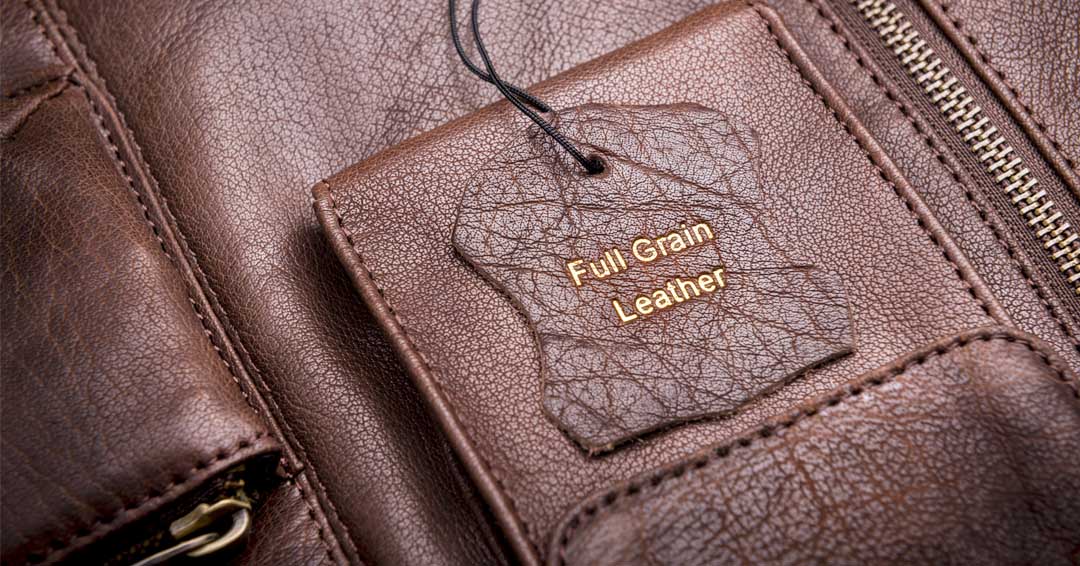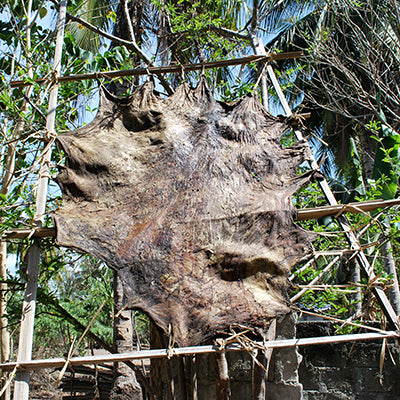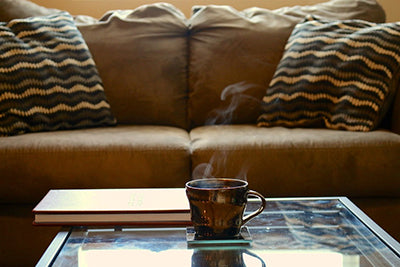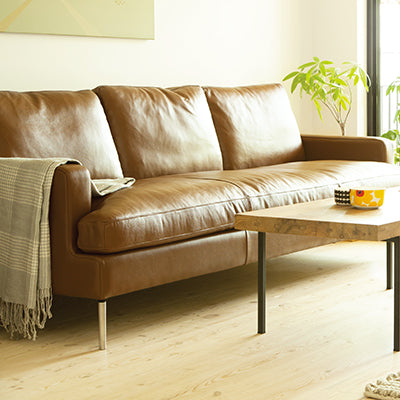Your Cart is Empty
Unique Purses Hand Tooled & Painted Leather Handbags for Women

Those who opt for the highest-quality leather handbags, however, will have one big choice to make: aniline and semi aniline leather. They are each made from the most desirable portion of the animal’s hide, the top layers known as full grain and top grain; the big difference is in the way that leather is dyed and treated.
The best way to gain a full understanding of semi aniline leather meaning and full aniline leather is to take a brief look at the history of leather and the process by which it is turned into handbags.
History of Leather ProductionYou don’t have to be a scholar or a regular viewer of the History Channel to know that ever since the earliest times, humans have used animal skins extensively for clothing and shelter. At first, the skins obtained from hunting and breeding were used “as is,” but it was quickly discovered that rubbing animal fat on the skins prevented them from rotting in the heat or freezing in the cold. That process was first described in ancient Assyrian texts and was the first type of treatment used on leather.

Over time, civilizations refined the ways they treated and tanned leather. Dehydration by exposure to the sun or through the use of salt and tanning with the fumes of burned plant bark or alum were methods recounted in texts from areas as diverse as Rome, Egypt, and India. The finished leather was primarily used for clothing and armaments, although it was also utilized to make tools, flasks, and even water pipes.
Tanning in the middle ages relied on similar processes once the skins were cleaned and separated. Tawing involved soaking the leather in a mix of potassium aluminum sulfate and salts; more conventional tanning took place in large pits or tanks filled with ground bark and vegetation-based solutions high in tannins, where the skins sat for a year or more before being dried, stretched, softened, and dyed. The use of lime to remove animal hair also became common during this time, speeding up the overall process of turning skins into usable leather.
It wasn’t until the time of the Renaissance that leather was widely used to upholster furniture and the same general process of cutting, tanning, and preparing leather was still being used. Leather couches and chairs were de rigueur among the upper classes, with some exquisitely-crafted leather furniture even considered fine artwork.
In the 19th century a discovery was made which revolutionized the tanning of leather. Surgeons had begun soaking sutures in a solution of chromium salts to improve their handling, and tanners realized that the same method could be used to tan leather. Combined with the replacement of tanning pits by rotating drums, the further discovery of new types of tanning materials and the development of machinery that simplified the separation of skins, the process of leather production continued to be refined. At the same time, the Industrial Revolution had facilitated more efficient, mechanized creation of furniture requiring leather upholstery – perfectly matching the growing demand for leather furnitur. Aniline leather vs full grain leather are two distinct types of leather, each with its own unique characteristics and production methods. While the evolution of leather tanning and production has led to more efficient processes, these two types of leather represent different approaches.
A Closer Look at the Leather Production ProcessWe’ve touched on the basics of how leather upholstery for modern furniture is produced, but to fully appreciate the difference between types of leather like full-aniline and semi-aniline it’s important to dig a bit deeper into the overall process. Many of these steps will sound familiar after reading the previous section.
Preparation
When a hide reaches the tannery, it is stored in rock salt to preserve it for processing. When the time comes to begin work, the skins are treated with anti-bacterial and anti-fungal agents and then rehydrated for several days in soaking drums; that also removes dirt and salt from the hides. They are additionally treated with lime which removes most of the epidermis, hair, grease, and fat while softening and swelling the skin, and excess flesh is removed from the underside. The skin then goes through a “dehairing” machine, followed by manual removal of remaining hair with a dull knife in a process called scudding.
Splitting
Next up is a trip through the splitting machine, where the hide is split into at least two layers. The top layer produces the highest-quality “full-grain” leather, that’s sought after for high-end upholstery because of its tight fibers which facilitate the display of the material’s grain and produce the trademark supple feel of fine leather. The underneath layer(s) are known as splits; these lower-grade leathers are used for lesser-quality upholstery, shoes, purses, and other leather products.
Tanning
This process is actually what turns an animal hide into leather, by stopping its decomposition, softening it, and preserving it for the long-term. Tanning is done in a large heated drum, where the hides rotate for as long as half-a-day in a solution primarily composed of vegetable agents like tree bark, chromium salts, or a mixture of the two.

Vegetable tanning produces firmer leather, while chromium contributes a supple feel to the tanned hide. Several other agents are usually added to the mix as well to maintain the solution’s pH at optimal levels.
Crusting
The hides are far from done after tanning; a number of sub-processes collectively known as crusting come next. Fat liquoring adds natural animal oils to strengthen the leather and make it softer, a trip through a “sammying” machine presses out any extra moisture, and a manual inspection allows the categorizing and grading of the leather according to its quality and appearance. Edges are trimmed and the hides are manually shaved as needed to ensure a consistent thickness.
It’s then back to the tanning and sammying machines for “retanning,” which is tailored to give each hide its desired properties, followed by drying via air, heat, or a vacuum machine. A number of other sub-processes like bleaching or stuffing may also be used before a final mechanical softening in a staking machine that massages the leather. After all of this work, the dried hides develop an outer crust (giving these combined treatments the name “crusting”) which is ideal for dyeing or other surface treatments.
Finishing
The leather that emerges after tanning and crusting isn’t yet suitable for most uses. The hides are put into tumbling drums for “milling” that further softens the leather and stretched on frames to tightening the fibers and stretch the upholstery. After that, blemishes may need to be removed or altered, the right amount of softness and gloss must be ensured, and in most cases the leather must be protected. The process of applying surface coatings to leather is a major aspect to finishing and there are many alternatives. For example, buffing top-grain creates nubuck, while buffing and brushing it produces suede. Abrasion can be used to “correct” defects in the grain, plating can create a polished appearance with a series of coatings, and artificial grains can be applied by embossing the skin. There are many varieties of protective coatings which can be applied as well.
The most important process for our purposes, though, involves the dyeing of leather which precedes the other types of finishing work. Dyeing adds the desired color to the final leather upholstery, of course, as the hides tumble in the selected dye for a number of hours to make sure they’re fully saturated. They’re then vacuum-dried or air-dried, making them ready for other finishing work.
Why is dyeing so important to our discussion of full aniline vs semi aniline leather? Read on.
Full-Aniline and Semi-Aniline LeatherMany people believe that the terms “premium select leather”, “full-aniline”, “fully-aniline” (often simply called aniline) and “semi-aniline” (sometimes referred as aniline plus leather) describe grades of leather. In reality, they are both high-quality full grain leather; the terms actually describe the type of dyeing and finishing that’s used, and how it affects the final look and feel of the leather. However, because only the most exquisite full-grain leathers are suitable for full-aniline treatment, aniline is indeed the highest level of leather upholstery.
First, what is aniline dye? It’s a chemical product with a carbon base that has been synthesized with other substances to create a transparent dye that can be produced in a variety of colors without losing saturation or clarity and leaves the grain pattern and surface characteristics of leather unchanged. It leaves the natural beauty of the upholstery unchanged while adding the desired color to the leather.

The process for dyeing full-aniline and semi-aniline upholstery begins in the same way. The leather is placed into large vats containing aniline dye of the chosen color and left until the dye completely penetrates the hide to create a fully-saturated and even-colored leather.
That’s the end of the line for aniline leather, unless a specific hand-finish (such as one providing an antique look) is applied. There’s much more to do on semi-aniline leather (also known as aniline-plus), though. Secondary pigments and/or finishes are added to the top surface by machine or hand and then a clear coating (usually polyurethane or a similar substance) is added for durability and protection against wear, stains, and exposure to light. The choice of that coating will also determine whether the leather has a glossy or matte finish.
That explains why only the very finest full-grain leather is suitable for full-aniline dyeing. The reason that additional pigments and finishes are added to semi aniline leather is to cover blemishes, slight color variations, and imperfections, creating a surface that has a uniform appearance. The approximately 5% of full-grain leather considered “perfect enough” to simply be aniline-dyed can be used for furniture upholstery without additional correction or modification. Some surface imperfections will always be visible on full-aniline leather but they are minor enough to contribute to the beauty of the leather rather than detract from its appearance.
It might seem that full-aniline would be the hands-down choice when choosing upholstery for leather furniture, assuming that the extra cost (understandably due to the higher-quality of the leather used for aniline leather) isn’t an obstacle. But there are many reasons why semi-aniline might be a better choice for the average home.
Semi Aniline Leather vs Aniline Leathers:
Pros and Cons
The lack of extra processing and finishing makes full-aniline leather the softest and most supple quality of leather you can find. The aniline dye is absorbed in varying amounts because of the way the skin cells are structured. It’s similar to the way natural wood absorbs stains. Therefore, distinctive color variations are the result. Natural marking are visible and there may be variations of texture and shade from one panel to another on a single sofa, for example. It’s also the most beautiful; the leather’s color stands out, the natural grain is on full display, it has a rich and luxurious look, it has the softest hand, and as it ages over time it develops the patina because stains are absorbed into the leather and that patina is what makes fine leather furniture so distinctive. For those reasons and many more, it is the most expensive leather out there.

There are downsides, however, to using gorgeous “unfinished” leather in your home. First, the leather will fade when exposed to sunlight and will scratch easily when compared to other leathers that have more protection added to them. More importantly, the proper care and maintenance of aniline leather is difficult since even a few drops of certain liquids can leave an indelible stain because of its porous nature and dirt/soil and even oils that are allowed to build up will quickly work their way into the leather. In other words, it is not stain resistant. Regular but light cleaning with distilled water (minerals in tap water will damage the leather), leather conditioners and, if desired, waterproofing or creams specifically designed for aniline leather are the only real options for long-term care.
That’s a losing battle if you have children and/or pets in your home. In those cases, semi-aniline leather, or better yet, pigmented (protective) leather, is a more sensible choice. The protective coatings applied to the upholstery after dyeing will make it more durable and allow it to resist/repel many stains, water, and many scratches. Semi-aniline leather is a happy medium where it features characteristics of high end leather with some protective properties. The use of water-based semi-aniline cleaners or gentle soap and water, combined with regular dusting, will keep semi-aniline leather clean and attractive for years with a minimal amount of maintenance.
What’s crucial to understand when considering semi-aniline leather couch furniture is that you’re not sacrificing a lot. Its uniform appearance may not quite match the unparalleled natural look and supple feel of full-aniline upholstery and it won’t develop a rich patina over the years, but it’s still beautiful, rich leather that’s soft to the hand – and it can withstand daily use and won’t fade quickly.
Comments will be approved before showing up.